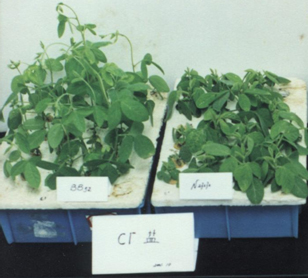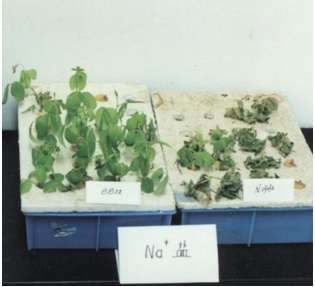Method for improving chlorine resistance of cultivated soybeans by utilizing wild soybeans in intertidal zones
A technology for wild soybeans and cultivated soybeans, applied in horticultural methods, plant genetic improvement, botanical equipment and methods, etc., can solve problems such as limited salt tolerance, narrow genetic basis, low yield and economic value of wild soybeans, and achieve grain yield The effect of quality improvement
- Summary
- Abstract
- Description
- Claims
- Application Information
AI Technical Summary
Problems solved by technology
Method used
Image
Examples
Embodiment 1
[0027] A method for improving the chlorine resistance of cultivated soybeans by using tidal flat wild soybeans, comprising the following steps:
[0028] (1) Select cultivated soybeans and wild soybeans for diallel hybridization, take the cultivated soybean Jackson as the female parent, cross with the male parent wild soybean BB52 after emasculation, and harvest hybrid F 1 substitute seeds;
[0029] (2) Field planting of F for several consecutive years 1 Generation seeds received to F 4 Generation, F 1 to F 4 The seedlings of each generation were treated with gradually increasing concentrations of salt, and the surviving soybean seedlings were desalted and cultivated until they matured and podded, and the seeds (such as 185 strains) were harvested. f 1 to F 4 The method that the seedlings of each generation were treated with salt with gradually increasing concentration was as follows: after emergence, the seedlings were treated with 50, 100, 150 and 200 mmol / L NaCl fo...
Embodiment 2 and Embodiment 3
[0032] Embodiment 2 and embodiment 3 methods are the same as embodiment 1, and the female parent, male parent, hybridization mode, backcrossing mode and result details that each embodiment adopts are shown in Table 1.
[0033]
[0034] Table 1 The detailed table of hybridization mode and test result of embodiment 2 and 3
[0035]
[0036] The above-mentioned embodiments are arbitrarily selected, and various indicators are tested on the growth process and the harvested seeds.
Embodiment 4
[0037] Embodiment 4: investigation of agronomic traits
[0038] Cultivated soybeans and wild soybeans of the tested parents and their F 4 The first-generation strains were sown in the field of the experimental farm in late May, and were routinely managed until November of the same year. The seeds were harvested after the seeds were fully ripe, and the plant height, number of pods per plant, number of branches, number of stem nodes, number of pods per plant and hundred Field agronomic indicators such as grain weight, and stored grain (F 5 generation). Such as image 3 and Figure 4 It was shown that the agronomic traits of pod and seed appearance, plant height, branch number and other agronomic traits of the hybrid progenies screened by hybridization and chlorine resistance were basically between the parents, but they were biased towards cultivated soybeans.
PUM
 Login to View More
Login to View More Abstract
Description
Claims
Application Information
 Login to View More
Login to View More - R&D
- Intellectual Property
- Life Sciences
- Materials
- Tech Scout
- Unparalleled Data Quality
- Higher Quality Content
- 60% Fewer Hallucinations
Browse by: Latest US Patents, China's latest patents, Technical Efficacy Thesaurus, Application Domain, Technology Topic, Popular Technical Reports.
© 2025 PatSnap. All rights reserved.Legal|Privacy policy|Modern Slavery Act Transparency Statement|Sitemap|About US| Contact US: help@patsnap.com



